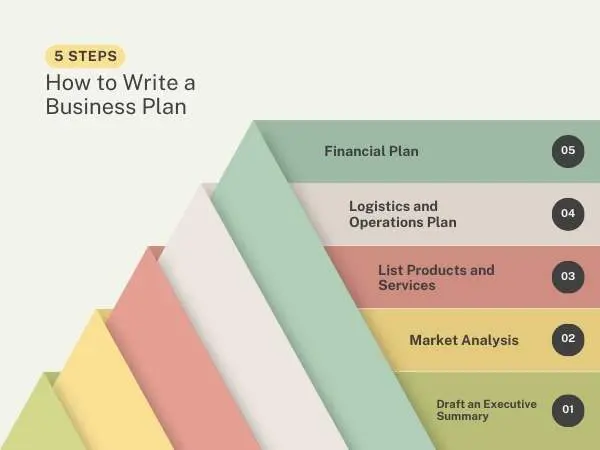How to Write a Business Plan With Examples
If you’re thinking of launching a business and have great ideas, pause before directly jumping onto execution. You first need a business proposal to guide you through every step and keep things on track. Learning how to write a business plan is a crucial step in this process.
Beyond your clarity, a business plan also helps you seek external support. Investors, vendors, and potential partners prioritize ventures that demonstrate a strong foundation and a clear path to profitability.
This article has all you need to know about how to write a business plan with the right format, guiding you through each essential component. Paired with inspiring examples, you’ll be set to craft an undeniably convincing business plan.
How to Write a Business Plan
Follow this step-by-step guide to learn how to create a business plan.
Draft an Executive Summary
The executive summary is the most important aspect of your business plan. It is like the first impression of your business proposal for bankers and investors. This quick overview includes all essential information.
It is written last, to concisely present all the significant points in one place. It should be kept short and to the point, packed with the most interesting details about your business.
Example: Executive summary should include Company name, Problem, Solution, Relative market, and Advantage. Canva templates are a great tool for assistance if you’re a beginner.
Business Description
Company description is the elevator pitch for your business plan. It hooks the investors in seconds by introducing the business– what it does and the problem it solves.
This intro is key to your business proposal. It grabs attention and convinces people that you’re the right choice. It also answers any initial questions and clears your stance as to why you’re in the market.
Example: Companies often term their descriptive section as an About page. Check this out for a better understanding of the company page.
Market Analysis
The market analysis section of your business plan holds vital significance. It confirms your thorough research about the market and also includes competitive analysis.
Your research about the target market reassures potential investors that you have a great understanding of your product market. Whereas, market analysis provides detailed information about this market, including demographics, geographic location, consumer behavior, and specific customer needs.
Example: If you’re creating a business plan for a brewing company, your SWOT market analysis should include strengths, weaknesses, opportunities, and threats.
List Products and Services
As you understand, how to write a business plan, you should know the significance the product and services section holds. This part of your plan makes it stand out. It includes what products you offer, and how uniquely they affect your customers.
This section offers a high-level overview if you have a diverse product range or dive deep into details for a smaller offering.
Example: For an Eco-friendly product company, your products and services page will include
- Product Description: This section will include the product line with further subdivisions (individual product pages, product categories)
- Sustainability Commitment: Highlighting their eco-friendly practices (sustainable ingredients, recycled packaging, company values)
Organization and Management
The organization and management section shines a light on the talented individuals who will steer your company toward success. It includes the mention of the team and legal structure of your business.
This legal framework further decides if your company will work as an S Corp, C Corp, LLC, or a sole proprietorship. For a detailed overview, you may also add the CVs of the key members of your business, as it helps investors gain better insights into the expertise of the business.
Marketing Plan
The sales and marketing plan is your company’s roadmap to getting your products into the hands of the right customers. It highlights what makes your business stand out and the channels you will use to reach your customers.
A marketing plan should include your current marketing choices and future strategies, all focused on how your business idea solves their problems. Be sure of where your target audience is found more, and then invest in major marketing sites like Facebook, Instagram, TikTok, etc.
Example: The company (XYZ) will utilize a multi-channel marketing strategy, including social media marketing and influencer partnerships. We will sell our products directly through website promotion and partner with XYZ retailers. Our pricing strategy will be competitive, offering premium solutions at an accessible price point.
Logistics and Operations Plan
While planning on how to write a business plan, considering the logistics and operational aspects of your business holds great significance. This plan acts as a blueprint for your company’s physical needs, from office space to equipment to staffing, supplies, and inventory management.
The level of detail in this section will vary on your business type. A home-based venture may just need a laptop and a stable internet connection, while a manufacturing company will have a complex web of raw material suppliers. Planning out logistics will help you keep all your needs mapped out and organized in one place.
Financial Plan
No matter how great your business idea is, its ultimate success hinges on its financial health. Investors and partners look for a business plan with clear profitability.
As you learn how to write a business plan, remember that financial planning is going to make or break your deal. This plan doesn’t require excessive details but should provide three key snapshots: an income statement, a balance sheet, and a cash flow statement, along with financial projections.
Use numbers, graphs, and charts to bring your financial plans to life. They make it easier for the reader to grasp the financial health and future potential of your business.
Example: An e-commerce brand, Nature’s Candy’s financial plan visualizes future sales, costs, and profits using graphs.
What to Include in These Business Plans
Learning how to write a business plan depends on which type of plan you wish to create as per your business. Here are a few business plan examples
One-Page Plan
When you’re writing a one-page business plan, make sure to keep it short and written with high-yield information. In this plan, you should include
- Executive summary
- Market analysis
- List of products and services
- Marketing Plan
- Operational plan
- Financial plan
Startup Plan
Even if you’re starting a small business and not a big fancy startup, you’ll need a business plan. A startup business should include
- Executive summary
- Company description
- Detailed market analysis
- Products list
- Marketing Plan
- Operational plan
- Financial management
Strategic Plan
A strategic plan outlines a long-term vision for propelling your business forward. It covers all aspects mentioned briefly in the startup plan in detail. If you’re confused about how to write a business plan that includes all, follow these steps.
- Executive summary
- Company description
- Comprehensive market analysis
- Product and services for business expansion
- Growth Marketing Plan
- Scalable operations strategy
- In-depth understanding of the financial plan
Final Words
This guide is a great starting point for learning how to write a business plan but remember, every business plan is different. You can change it according to your criteria, as it fits best.
Make sure to keep it well-versed and easy for your vendors to understand. By putting in the work to write your business proposal, you’ll soon be on your way to turning your idea into a successful business.





